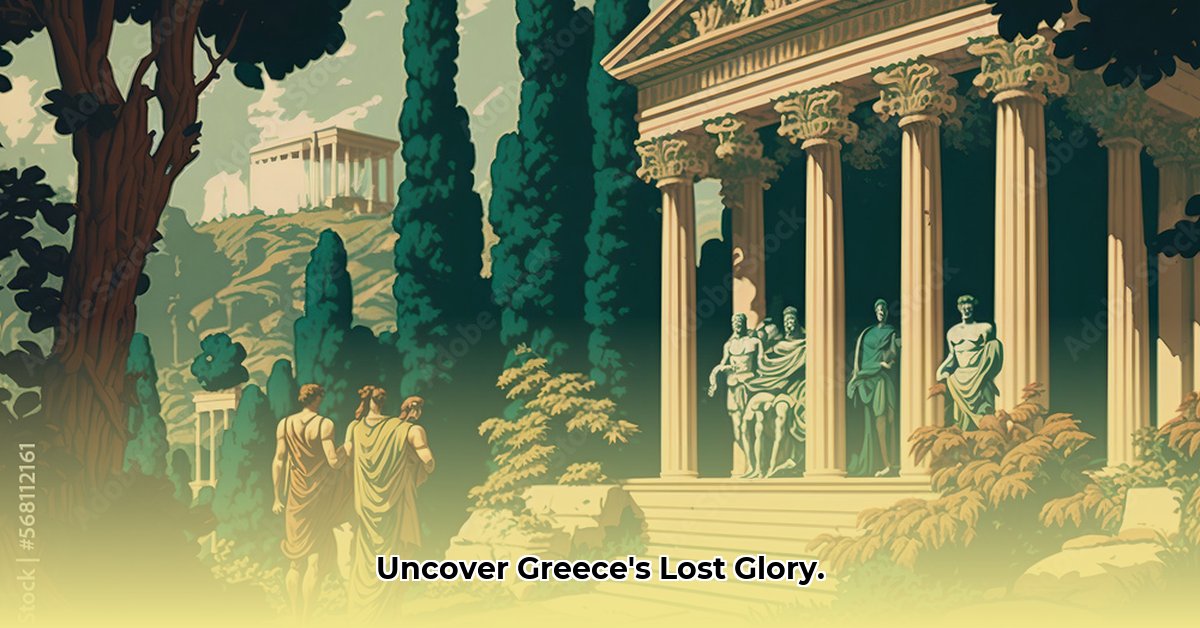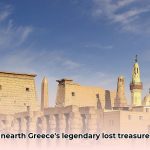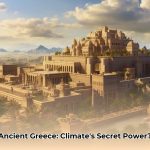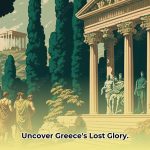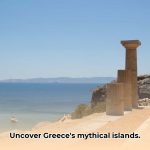Ancient Greece, the cradle of Western civilization, gifted the world with groundbreaking innovations in art and architecture that continue to inspire awe and admiration. From the symmetrical perfection of the Parthenon to the lifelike realism of its sculptures, the artistry of ancient Greece reflects a profound understanding of aesthetics, engineering, and the human spirit. For more information on significant sites, check out this list of landmarks in Ancient Greece. This comprehensive guide delves into the fascinating world of ancient Greek art and architecture, exploring its evolution, key characteristics, and enduring legacy.
Art and Architecture Through the Ages
Embark on a journey through time to explore the remarkable art and architecture of ancient Greece, a testament to human ingenuity and a legacy that continues to shape our world.
Origins and Foundations: The Rise of Minoan and Mycenaean Civilizations
The story begins long before the classical period, with the rise of the Minoan and Mycenaean civilizations. Flourishing on Crete and the Greek mainland respectively, these cultures laid the groundwork for later artistic developments. Minoan art, characterized by its vibrant frescoes and elegant pottery, reflects a sophisticated and peaceful society. Mycenaean art, on the other hand, showcases a more militaristic culture, with its focus on fortified citadels and elaborate metalwork. The iconic Lion Gate at Mycenae stands as a testament to their architectural prowess.
The Dawn of Sculpture: Geometric and Archaic Periods
Following the decline of the Mycenaean civilization, Greece entered a period known as the Dark Ages. From this emerged the Geometric period, marked by a resurgence of artistic activity, particularly in pottery. Geometric designs and stylized figures adorned vases, kraters, and amphorae. The Archaic period (800-480 BCE) witnessed the development of monumental sculpture, with the emergence of the kouroi (male) and korai (female) figures. These statues, often dedicated to gods and goddesses, were characterized by their stiff, frontal poses and enigmatic smiles, reflecting an early, stylized approach to representing the human form.
Classical Grandeur: The Golden Age of Greek Art
The Classical period (480-323 BCE) represents the pinnacle of Greek artistic achievement. This era saw remarkable advancements in sculpture, architecture, and painting. Sculptors like Phidias, Myron, and Polykleitos revolutionized the representation of the human form, achieving a new level of realism and idealization. The Doryphoros (spear-bearer) by Polykleitos, exemplifies this mastery, embodying the concept of contrapposto, a natural stance with weight shifted to one leg, creating a sense of balance and dynamism.
Magnificent temples, such as the Parthenon in Athens, were constructed, showcasing the Doric, Ionic, and Corinthian architectural orders. These structures were not merely buildings; they were powerful symbols of civic pride, religious devotion, and artistic excellence.
Hellenistic Emotion: The Shift in Artistic Expression
The Hellenistic period (323-146 BCE), following the death of Alexander the Great, witnessed a shift towards more dramatic and emotional expression in art. Sculptures became more dynamic and expressive, portraying a wider range of human emotions and experiences.
Architectural styles became more ornate and grandiose, reflecting the wealth and cosmopolitanism of the Hellenistic world. The Library of Alexandria, a center of learning and culture, flourished during this era, fostering intellectual and artistic exchange.
Defining Elements: Understanding Architectural Orders
The Doric, Ionic, and Corinthian orders are the fundamental building blocks of Greek architecture, each possessing distinctive characteristics and proportions.
- Doric: The simplest and most austere of the orders, the Doric order is characterized by its sturdy columns with plain capitals and fluted shafts. The Parthenon is a prime example of Doric architecture.
- Ionic: More elegant and refined than the Doric order, the Ionic order features slender columns with voluted capitals (scroll-like ornaments) and a base. The Temple of Athena Nike on the Acropolis showcases Ionic features.
- Corinthian: The most ornate and elaborate of the orders, the Corinthian order is distinguished by its capitals adorned with acanthus leaves. The Temple of Olympian Zeus in Athens exemplifies Corinthian architecture.
Power and Influence: Patronage and Artistic Funding
Art in ancient Greece was often supported by wealthy patrons, including religious institutions, government officials, and private individuals. Pericles’ patronage of the arts during the Golden Age of Athens led to the construction of the Parthenon and other iconic monuments on the Acropolis. These patrons played a crucial role in shaping artistic trends and fostering creativity.
Modern Connections: Enduring Artistic Legacy
The influence of ancient Greek art and architecture resonates throughout Western art and culture. From the Renaissance to Neoclassicism, artists and architects have drawn inspiration from the principles of balance, harmony, and proportion that define Greek aesthetics.
Greek architectural elements, such as columns, pediments, and friezes, are commonly found in modern buildings, while Greek sculptures continue to be admired and emulated for their realism and beauty.
Preservation Imperatives: Addressing Challenges and Threats
Despite their enduring legacy, ancient Greek art and architecture face numerous challenges, including weather damage, pollution, vandalism, and looting. Preservation efforts are essential to protect these cultural treasures for future generations.
Archaeologists, conservators, and historians work tirelessly to restore damaged monuments, document artifacts, and educate the public about the importance of preserving cultural heritage.
Practical Application: Steps for Preservation and Enjoyment
Here are concrete steps to protect and appreciate ancient Greek art and architecture:
- Visit Museums and Archaeological Sites: Explore collections of Greek art in museums around the world and visit archaeological sites to experience the grandeur of ancient Greek architecture firsthand.
- Support Preservation Efforts: Contribute to organizations dedicated to preserving and restoring ancient Greek monuments and artifacts.
- Learn About Greek Art and Architecture: Read books, articles, and online resources to deepen your understanding of Greek art and architecture.
- Promote Cultural Heritage: Share your knowledge and appreciation of Greek art and architecture with others, encouraging them to explore and support its preservation.
- Advocate for Responsible Tourism: Practice responsible tourism when visiting ancient Greek sites, respecting the environment and local communities.
Everlasting Appeal: The Timeless Power of Ancient Greece
Exploring ancient Greek art and architecture offers more than just an aesthetic experience; it provides a window into a remarkable civilization, its values, and its enduring influence on the world. Their art and architecture continue to inspire and captivate, reminding us of the power of human creativity and the importance of preserving our cultural heritage.
Mathematical Harmony: Analyzing Greek Principles in Architecture
Key Takeaways:
- Ancient Greek architects masterfully integrated mathematical principles into their designs, resulting in structurally sound and aesthetically pleasing buildings.
- Geometry, proportion (including the Golden Ratio), and grid systems were fundamental tools.
- Analyzing these principles requires examining surviving structures, studying historical texts, and employing modern measuring techniques.
- Understanding the interplay between mathematics, aesthetics, and societal context is crucial for a complete analysis.
- The impact of Greek mathematical principles extends far beyond antiquity, influencing architectural styles through the ages.
Geometric Foundations: The Cornerstone of Design
Ancient Greek architects were masters of geometry, employing circles, squares, and other geometric shapes to create structures of exceptional beauty and structural integrity. The Parthenon, for example, is based on a series of carefully calculated geometric proportions, ensuring visual harmony and stability.
The Golden Standard: Proportion and Aesthetics
The Golden Ratio (approximately 1.618), also known as the Divine Proportion, appears frequently in Greek architecture, creating a sense of visual balance and harmony. This ratio is found in the proportions of columns, friezes, and other architectural elements, lending a sense of timeless beauty to Greek buildings.
Order and Structure: Grid Systems and Planning
Greek cities were often laid out on grid systems, a practical approach to urban planning that simplified construction and enhanced functionality. The city of Miletus, designed by Hippodamus in the 5th century BCE, is a prime example of a grid-planned city, with its rectangular blocks and orderly arrangement of streets and public spaces.
Interwoven Beliefs: Mathematics and Societal Values
Mathematics was deeply intertwined with Greek philosophy and religious beliefs. The Pythagoreans, for example, believed that numbers held the key to understanding the universe, and their ideas influenced the design of temples and other sacred structures. The concept of symmetria, meaning “commensurability” or “harmonious proportion,” was central to Greek aesthetics and reflected their belief in the inherent order and beauty of the cosmos.
Analytical Approach: A Step-by-Step Guide
- Identify the Structure: Select a specific building or city plan for analysis.
- Gather Data: Consult historical records, archaeological findings, and modern measurements to gather information about the structure’s dimensions, materials, and construction techniques.
- Analyze Geometric Shapes: Identify the geometric shapes used in the design of the structure, such as circles, squares, rectangles, and triangles.
- Measure Proportions: Calculate the ratios between different parts of the structure, looking for instances of the Golden Ratio or other significant proportions.
- Examine Grid Systems: Study the layout of the city or building to determine whether it follows a grid system or other organized plan.
- Consider Cultural Context: Research the philosophical and religious beliefs of the ancient Greeks and how these beliefs may have influenced their architectural designs.
- Interpret Findings: Draw conclusions based on your analysis and research, explaining how mathematical principles were used to create visually harmonious and structurally sound buildings.
Innovation and Style: Architectural Variations and Techniques
Key Takeaways:
- The evolution of ancient Greek architecture from simple, perishable structures to magnificent stone edifices showcases remarkable engineering progress.
- Regional variations in architectural styles reflect diverse resources, cultural influences, and local traditions.
- Innovative construction techniques, including advanced stone-joining methods and the use of sophisticated lifting devices, enabled the creation of impressive structures.
- The legacy of ancient Greek architecture continues to inspire architects and engineers today.
Material Evolution: From Humble to Monumental
Early Greek structures were built using mudbrick and timber, materials that were readily available but not particularly durable. The shift to stone architecture around the 7th century BCE marked a pivotal moment in Greek architectural history. Stone, particularly limestone and marble, offered greater strength, durability, and aesthetic appeal.
Dissecting the Orders: A Stone Symphony
The three main architectural orders – Doric, Ionic, and Corinthian – each possess distinct features that dictated the structural elements and influenced the overall design of Greek buildings.
- Doric: Characterized by its simple, sturdy columns with plain capitals and fluted shafts, the Doric order conveyed a sense of strength and austerity.
- Ionic: More elegant and refined than the Doric order, the Ionic order featured slender columns with voluted capitals (scroll-like ornaments) and a base.
- Corinthian: The most ornate and elaborate of the orders, the Corinthian order was distinguished by its capitals adorned with acanthus leaves.
Regional Styles: Reflecting Cultural Diversity
Ancient Greek architecture was not uniform throughout the Greek world. Regional variations in architectural styles reflected the diverse resources, cultural influences, and local traditions of different regions. Doric temples predominated in mainland Greece and the western colonies, while the Ionic style flourished in Ionia (the west coast of present-day Turkey) and the Aegean islands. The Corinthian order emerged later in Athens and was widely adopted throughout the Hellenistic world.
Monumental Engineering: Techniques and Solutions
The construction of ancient Greek temples and other monumental structures required sophisticated engineering techniques and innovative solutions. Greek architects employed advanced stone-joining methods, using metal clamps and dowels to hold the blocks of stone together.
Evidence suggests that the Greeks also used sophisticated lifting mechanisms, possibly employing cranes and ramps, to raise the massive blocks of stone into place.
Enduring Design: A Lasting Legacy
Ancient Greek architecture left an indelible mark on the world, influencing Roman architecture and continuing to inspire architects and engineers today. The principles of balance, harmony, and proportion that defined Greek aesthetics have been adopted and adapted by countless cultures throughout history, ensuring that the legacy of ancient Greek architecture will endure for centuries to come.
Patronage Unveiled: Art in Religious, Political, and Social Spheres
Imagine ancient Greece. What fueled the creation of its art? The answer lies in understanding the patronage of art in its religious, political, and social contexts.
Divine Influence: Religious Dedication
Religion played a central role in ancient Greek life, and temples were among the most important buildings in any city. These temples were not merely places of worship; they were also lavish offerings to the gods, demonstrating piety, wealth, and artistic skill. Sculptures of deities, such as Zeus, Athena, and Apollo, were central to religious rituals and were often housed within the temples.
Power Statements: Political Ambitions
Political leaders used art to bolster their authority and promote their agendas. Victories in battle, such as the Persian Wars, were immortalized in sculptures and architectural monuments, showcasing the power and triumph of the state. The Parthenon, built during the Golden Age of Athens under the leadership of Pericles, served as a symbol of Athenian democracy and cultural supremacy.
Personal and Public: Social Expressions
Private individuals commissioned funerary monuments, votive offerings, and decorative objects to express their social status, commemorate loved ones, and fulfill religious obligations. These works of art, often smaller in scale than public monuments, provide valuable insights into the daily lives, beliefs, and values of ordinary Greeks.
Evolving Tastes: Reflecting Societal Shifts
Greek art styles mirrored societal shifts and evolving cultural values. The rigid archaic smiles of early sculptures gave way to the more naturalistic poses and expressive features of classical art, reflecting a growing emphasis on humanism and individualism.
Material Differences: Beyond the Marble
The choice of materials – marble, bronze, terracotta – and the intended location (public versus private) influenced the style, function, and long-term preservation of ancient Greek art. Marble, prized for its beauty and durability, was used for monumental sculptures and architectural elements, while bronze was favored for statues and vessels. Terracotta, a more affordable material, was used for pottery, figurines, and architectural decorations.
Preservation Challenges: Protecting a Valuable Heritage
Despite its enduring legacy, ancient Greek art faces numerous challenges, including weathering, pollution, vandalism, and looting. Modern efforts, which boost city development, focus on restoration, ethical acquisition practices, education, and technological advancements to protect and preserve this valuable heritage for future generations.
Key Takeaways:
- The patronage of ancient Greek art was a complex interplay of religious beliefs, political power, and individual aspirations.
- Religious structures like temples were significant displays of communal faith and civic pride.
- Political leaders leveraged art to showcase their achievements and power.
- Private individuals commissioned works to enhance their social standing and commemorate loved ones.
- Stylistic shifts in Greek art directly reflected the evolving social, political, and philosophical landscape.
- The choice of material significantly impacted both the artistry and the long-term preservation of the art.
- Preservation efforts are ongoing to protect and restore this valuable heritage.
- Explore the Marathon Ancient Greece Map: A New Perspective on the Iconic Battle - August 12, 2025
- Explore Ancient Greece Drawings: Styles, Periods and Enduring Examples - August 12, 2025
- Ever Wondered About Toxic Truths? Makeup in Ancient Greece Unveiled! - August 12, 2025
